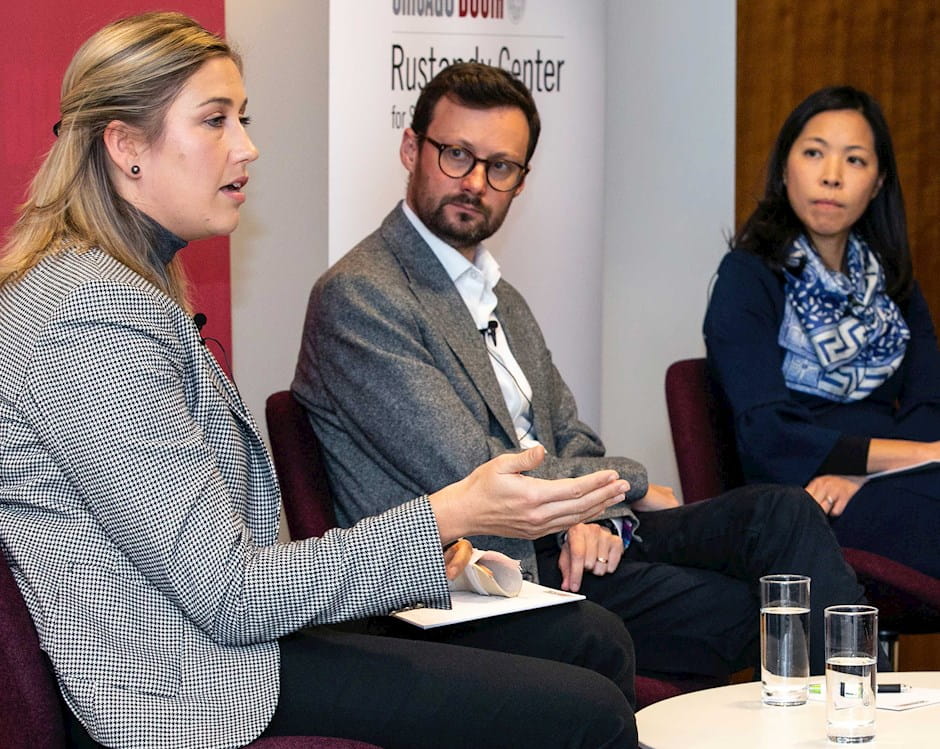Although the term impact investing was only coined a dozen years ago, investments that abide by its tenets account for over $500 billion of assets under management, according to the Global Impact Investing Network. At its heart is the idea that investing in a company can produce a positive outcome—if a proper impact management approach is applied.
“Part of your investment thesis is an expected social outcome,” said Priya Parrish, ’09, an adjunct assistant professor at the University of Chicago Booth School of Business, impact investor in residence at Chicago Booth’s Rustandy Center for Social Sector Innovation, and managing partner at Impact Engine.
This raises many questions. What is the impact? How does the company achieve that? How is that measured? How does it create that impact? To answer these, the Rustandy Center brought together three UK-based impact investors for a discussion at Chicago Booth’s London campus on November 19, 2019.
Maggie Loo is a partner at Bridges Fund Management whose funds are focused on four thematic strategies — healthier lives, sustainable planet, future skills, and stronger communities. Paul Miller is CEO at Bethnal Green Ventures, an early-stage “tech for good” venture capital firm. Alexis Crusey is a senior manager on the investor relations team at LeapFrog, which focuses on investments in Asia and Africa.
Focus on impact
One challenge is assessing the expected impact of investments. Because of its focus on early-stage companies, Miller said his team wanted to know entrepreneurs had a deep understanding of the problems they were trying to solve.
“They should be proposing a product or service where the more they sell, the more positive impact there will be,” he said. Bethnal Green Ventures targets investments in the areas of health, education, climate change, and democracy. “In each case we are trying to produce solutions that will reduce inequalities.”
One investee is Our Path, which provides health programs for people diagnosed with pre-diabetes. It has a better record of preventing the onset of the disease among a wider socioeconomic group than other programs, Miller said.
Loo said Bridges analyzes impact by looking at investments through the five dimensions of impact per the Impact Management Project: what the outcome is, how great it is, who is being impacted, what would have happened without the investment, and what are the risks.
She also highlighted an example from the health sector, pointing to The Gym Group that at launch provided affordable access to fitness centers with no joining fee. One metric it used as the business grew was what percentage of customers had not had gym memberships previously. “We needed to know we were not just taking members from other centers,” she said.
The importance of audit
Given the importance to investors of knowing their investments are delivering social impact, verification is essential. The International Finance Corporation, an arm of the World Bank, in consultation with a core group of impact investors and other external stakeholders, developed the Operating Principles for Impact Management, which supports the development of the impact investing industry by establishing a common discipline around the management of investments for impact from origination to exit.
Crusey said LeapFrog, which is a signatory to the principles, had gone further with its own impact measurement methodology. “As a sector specialist, we knew we couldn’t be everything to everyone,” she said. With a distinct focus on financial services and healthcare, LeapFrog sets financial targets aligned with social impact goals in the relevant subsector.
For example, as part of its investment in a Ghanaian insurance firm, LeapFrog’s impact measurement framework looks not only at its financial performance but at key metrics such as renewal rates and claims numbers to check that underlying customers demonstrate that they value the product they purchased (renewal rates) and feel able to use the policies (claims ratios) to protect against risks.
Funds add value
Parrish asked Crusey what LeapFrog’s “secret sauce” behind its success was and whether it was due to its focus on impact or simply good investing.
She said African markets were difficult to invest in. “Not anyone can go there and do well,” she said. “These markets are not the easiest. What has proved well for us has been a hands-on operational approach.”
No matter the approach, speakers were clear: Investments have the potential to generate both financial and social returns, but only when firms properly measure and manage impact.
If you'd like to receive updates on social impact stories, events, and research at Chicago Booth, sign up for the Rustandy Center's newsletter. Note: We want to demonstrate our commitment to your privacy. You can review Chicago Booth’s privacy notice for more information.


